Subject:
The Gate was open, so
we passed through
Date: Tue,
09 Sep 1997 17:33:02 -0700
7:55 Gasconade
Hills RV Park; Hazelgreen, Missouri :: 07 SEP 97
You're probably wondering what happened with that broken spring.
Well, it devolved into a relatively minor problem: an RV shop was just
a couple miles away, the repair took an hour, the spring cost $26 bucks+tax,
total bill $68+change, we were on the road by 10AM, which is an hour earlier
than usual.
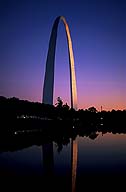
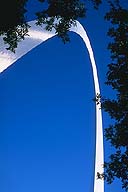
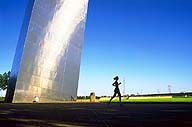
Gateway to the West
St. Louis, Missouri
|
But we're miles from that now. Miles even from the Gateway to
the West, Saint Louis. I've been replaying some history for you, history
that's related to the eventual designation of Route 66 as the first 'transcontinental'
highway and related to the significance of including cities like Chicago,
Saint Louis, Santa Fe and Los Angeles on the Route.
When I began researching the prehistory of Route 66 I was disappointed
to find that it did not very closely follow the Santa Fe trail. In fact,
the two intersect in only a few places and are parallel only through part
of Texas and New Mexico; they were primarily routes of trade and westward
migration; and, of course, both reach Santa Fe-but there is little else
by which to compare them. When I think about it now, that shouldn't surprise
me. Technological advances change our modes of travel, alter the requirements
of the trails, roads or rails over which we travel and often force us
to select new routes. The Santa Fe trail was blazed over a century before
the first US ROUTE 66 sign was erected by traders armed with very inarticulate
maps of the region. By the time Route 66's architects drew a single line
on a topographical map, they had established roadways to choose from and
topographical maps with which to compare them; they could bridge the widest
rivers, tame the surliest inclines with dynamite and internal combustion
engines and tunnel through stubborn hillsides.
But as the history unfolds for me, I am not surprised to find
several nodes on the Route 66 map of great historical significance in
the flow of traffic between East and West. The Chicago stockyards slaughtered
the pigs and beef driven in by train, truck or hoof from western ranches.
The Eerie Canal reduced travel time between New York and Buffalo by 1/3
and shipping costs were lowered to 1/10th the previous rate. In time,
the Eerie would be largely superseded by the railroads and the St. Lawrence
Seaway (once the on-again-off-again thing with the Canadian Brits settled
down and everyone agreed on the present borders), but not before helping
to establish Chicago as an important trade link, and an important node
on the route westward.
23:35 Gasconade Hills RV Park; Hazelgreen, Missouri
:: 07 SEP 97
Situated on the Mississippi's west bank, just south of that
river's confluence with the Missouri River, Saint Louis has long been
the portal to America's west.
23:00 KOA Kampground; Joplin, Missouri :: 08
SEP 97
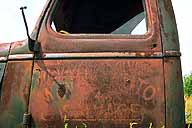
Where grand old vehicles lie in rest
Somewhere along the Mother Road in Missouri


|
I don't know how well I'm going to be able to write here. I'm
currently connected and downloading 48 odd pieces of email, most of them
likely e-junk, from my collecting bin account. (My personal account seems
to have eluded the email-marketing distribution lists so far, but not
my other accounts. These I direct to a single bucket that only occasionally
gets downloaded...) Anyway, I'm connected via a well-lit phone booth at
the KOA. Well-lit means bug-infested and though most of the blighters
here are not biters, they're still an unholy nuisance, to say the least:
buzzing, crawling, slipping inside my t-shirt. That, and the light is
provided by one of those gamey green fluorescent tubes and my stomach's
turning green in sympathy with the apparent colour of my hands.
But we're on 20 of 48, at the rate of 2 a minute or so and rather
than waste the time, I'll try to add a few more lines of the Route-66
back-story. Back-story is a screen-writing term referring to the story
that happened before the opening credits of the film. It's used by screen
writers to develop their characters, give them a personal history, and
thus flesh out how they'll behave when faced with the obstacles and other
events occurring in the film. Writing a credible character depends on
building a complete back history. Understanding Route 66 requires the
same attention to the history preceding even its conception. None of the
guides and other Route 66 resources go back this far, and the result is
a gee-whiz approach placing two characters as the fathers of Route 66;
one of them in particular is considered of tantamount importance. I find
this interpretation of The Mother Road's genesis, well, simplistic. So,
back to St. Louis.
But first, I'm going to take a break from the bugs...pthui...did
I mention about them flying into open orifices? AAAAHH!
...Or giant cicadas flapping by like baseball cards in bicycle
spokes? YIKES!!
40 of 48, almost there...and then there's the regular mail.
Er, St. Louis. Right, portal to the West. Most people are familiar
with the Gateway Arch in St. Louis. Erected in the 1960s it stands over
600 feet tall, the tallest thing in St. Louis...for the time-being. I
wonder how many know the arch is there to remind us all that during the
years of American westward expansion, the overwhelming majority of food
and supplies bound west of the Mississippi went through Saint Louis?
Ead's Bridge represented the first crossing for vehicles and
trains of the lower Mississippi. This heavily influenced the development
of the railways in the mid-west. A brief documentary on Ead's Bridge is
shown at the St. Louis History Museum. It's interesting to watch the time-lapse
expansion of railways in the late 18th and early 19th centuries. West
of the Appalachians, a spider's web begins to grow around Chicago. A feeder
shoots out to Saint Louis, and another spider's web begins and the two
hubs gradually grow together.
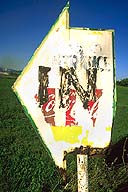
Sightseeing Route 66
Somewhere along the Mother Road in Missouri
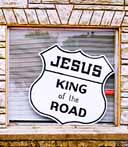
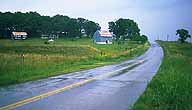
|
10:30 KOA Kampground; Joplin, Missouri :: 09
SEP 97
Bloody bugs.
We'll be getting into Oklahoma today, after nicking off a corner
of Kansas, which is home to all of a dozen miles of Route 66. I've put
down Kerouac for the moment and
have picked up Steinbeck's "The Grapes of Wrath." This is an account of
the dustbowl era and the Joad family who leave their Oklahoma farm and
head out for California on Route 66. I'll be getting into that over the
next week or so as we cross Oklahoma, but for the moment I'd like to quickly
finish off the Route 66 back-story.
So most everything going west of the Mississippi went through
Saint Louis. From there, if you were serious about heading west, you headed
west and slightly north for Independence, Missouri, now part of Kansas
City's urban sprawl and the trail head for the Santa Fe trail, the Oregon
trail and numerous other less famous westward routes.
Route 66 doesn't go to Independence, rather it crosses the Kansas
border at Joplin. Early 19th century trailblazers sought beaver pelts
and, later, tillable land. In the latter half of that century, enormous
deposits of lead and zinc would be discovered where Kansas, Missouri and
Oklahoma meet and Joplin became the center of the mining activity.
Keeping on the mineral track, the world's first oil well was
drilled in Oklahoma and Tulsa once referred to itself as the "Oil Capitol
of the World."
Further on down the line, Santa Fe lay at the terminus of the
Santa Fe Trail and it remained the center of trade for the American southwest
well into the 20th century. A route through Santa Fe also crossed the
western mountain ranges over the high plateau. This reduced the cost of
engineering by reducing the mountainous terrain over which the route would
run. Los Angeles, then, became the obvious Pacific Coast terminus for
the proposed highway.
I'll get into some of the other cities as we pass through them.
I'm trying to establish the commercial significance of Route 66 as an
artery of trade. By the 1920s, trucking was beginning to take a bite out
of the railroad shipping industry. The trucking lobby was a formidable
ally of the drive to construct interstate and transcontinental roadways,
so any move to establish a highway needed to please the growing trucking
industry.
But there's a more direct commercial link. The two men who were
Route 66's greatest promoters were businessmen of no small means. The
guidebooks and histories I've read indicate both were "dedicated to the
idea of establishing a broad network of interstate highways" but it's
no small coincidence the route they committed themselves to happened to
pass through their hometowns of Saint Louis and Oklahoma City. The practical
preceded the mythical.
Not that the mythical element had no part to play. After receiving
official designation for their route, the two men continued to promote
the highway, participating in the first cross-country run, a marathon
of nearly 3,500 miles from Los Angeles to New York City. This run followed
Route 66 in its entirety from LA to Chicago.
~~~ Responses Sought ~~~
Advertising is
the rattling of a stick
inside a swill bucket.
| |
 |
attributed to George Orwell |